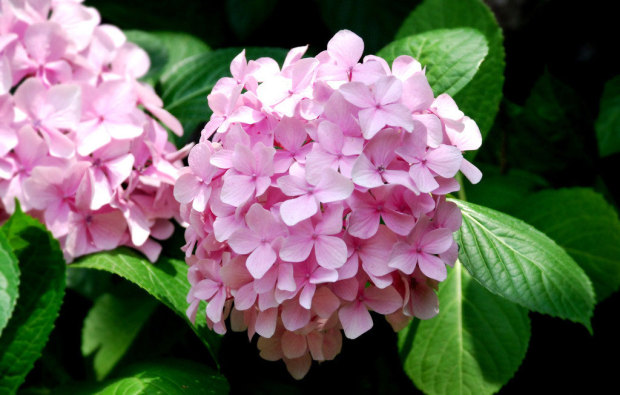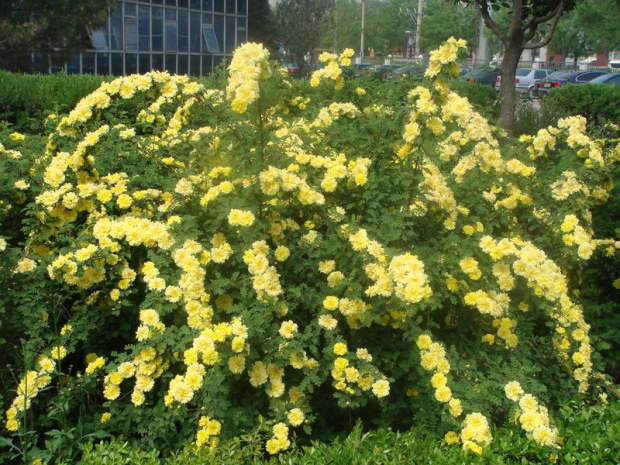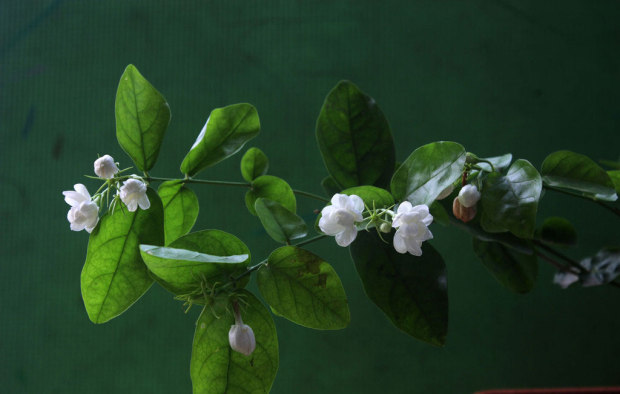Cultivation and Culture methods of Hydrangea
Hydrangea, because of its corymbose inflorescence with most sterile flowers, as few as eight, many are innumerable names; and because of its tight inflorescence, shaped like hydrangea, it is named hydrangea, it has two types of flowers, small flowers in the middle, bisexual, fruiting after flowers; large flowers outside, scattered around, and no stamens, only play the role of attracting insects and setting off the flower core. Sterile flowers developed from 4 sepals, initially green-white, and then gradually changed to pink to blue-purple. Each flower is small, but the whole inflorescence can be up to 15 cm in diameter. You can watch it from June to August. Varieties cultivated in the garden also have Douqiu, also known as Hydrangea, inflorescences are all sterile flowers, ornamental effect is better; Ziyang flower, corymbose inflorescences are the largest, up to 20 cm, inflorescences are almost all sterile flowers, flowers and colors are all blue-purple, is the best variety of hydrangea; silver-edged hydrangea, flowers with hydrangea, but the leaf edge is white, flowering mainly, leaves can also be seen when there is no flower.

Hydrangea originated from the Yangtze River Basin in China to Guangdong and Fujian. Sex likes warmth, shade and wetness; requires fertile, humus-rich and well-drained moist soil, micro-acid, micro-alkali and neutral soil can grow well, but the alkaline is heavy, so the ph value is 7. More than 5% of the land will grow poorly. It can be cultivated in the open field in the south of the Huaihe River basin. In the north, the outdoor pot plant overwinters indoors, and the lowest temperature should be above 10 degrees. If you can maintain the room temperature, you can watch the flowers all the year round. Cuttings, strips and ramets can be used for propagation, and transplanting is the easiest, hardwood and tender wood can be used; it can take root in about one and a half months at a temperature of about 20 degrees and 80% relative humidity, and can be put on the basin after 2 months. Pay attention when cutting, hydrangea is a negative plant, must not be too exposed to the sun. Matters needing attention in cultivation, management and culture of hydrangea
Hydrangea is known as ball orchid, also known as eight Immortals, Ziyang Flower, Seven changes, Hydrangea, Noodle Flower, originated in Sichuan, China and Japan. It is a deciduous shrub of Hydrangea of the family Hydrangea of Cornus. The flowers are almost asexual, and the so-called "flowers" are just sepals. The eight Immortals were cultivated earlier in China, and hydrangea was planted in the gardens in the south of the Yangtze River built in the Ming and Qing dynasties. The park built at the beginning of the 20th century is also inseparable from the planting of hydrangea. Modern parks and scenic spots are planted in pieces to form a landscape. Artificially cultivated hydrangea flowers are colorful, with blue, white, purple, pink, pink and other colors, is a common ornamental flowers and trees.
Growth habits of Hydrangea
We must first understand the growth habits of hydrangea before we can pertinently master the breeding methods of hydrangea. Hydrangea is native to the Yangtze River Basin in China and is fond of warm, moist and semi-shady environment. Afraid of drought and waterlogging, it is not cold-resistant. In cold areas, the aboveground parts wither and die in winter, and new shoots will not sprout again until the next spring. Hydrangea likes the light loam which is fat, moist and well drained, and has strong adaptability. The acidity and basicity of the soil had a great influence on the flower color of hydrangea, which was blue in acidic soil and red in alkaline soil.
Propagation method of Hydrangea
Cuttings, ramets, striping and grafting are commonly used for propagation, mainly cuttings. During the Meiyu period, strong twigs on young mother trees can be selected as cuttings, with nodes at the base of cuttings, stained with mud, about 20 cm long, and the lower leaves can be removed. The suitable temperature of cuttings is 1 3-18 ℃, shade is needed after cutting, it is often kept moist, rooting takes place in about 15 days to 1 month, and can be transplanted in the second year after survival. Ramet propagation should be carried out before sprouting in early spring. Separate the rooted branches from the mother plant, pot directly, watering should not be too much, maintain in the semi-shady place, wait for new buds to sprout and then transfer to normal maintenance. Striping propagation can be carried out during bud germination, grow after 30 days, cut off from the mother plant in the following spring, transplant with soil, and blossom in the same year. In general, high pressure is carried out from March to April in spring, and it can take root from June to July, and it can be cut and planted in the same year. Grafting propagation uses Qionghua seedlings as rootstocks, cutting in spring, easy to survive. Transplanting should be carried out after defoliation or before budding. The main branch is easy to sprout and grow, and it needs to be pruned properly after flowering to shape the tree.
Cultivation and Management of Hydrangea
The optimum temperature for the growth of Hydrangea is 18-28 ℃, and the winter temperature is not lower than 5 ℃. Flower bud differentiation takes 6-8 weeks under the condition of 5-7 ℃. The temperature of 20 ℃ can promote flowering, maintain 16 ℃ after anthesis, and prolong the flowering period. But the heat makes the flowers fade quickly. Hydrangea is a short-day plant, which is treated in the dark for more than 10 hours every day and forms flower buds in about 45-50 days. Potted hydrangea is commonly used in 15cm pots. Potted plants should be fully watered after sprouting in spring to ensure that the leaves do not wither. During the florescence from June to July, there should be sufficient fertilizer and water, and fertilization should be applied once a month. Usually cultivation should avoid the hot sun, and 60%-70% shading is the best. When the light is too strong in midsummer, proper shading can prolong the flowering period. The stem of the flower is removed after flowering to promote the formation of new branches.
The sandy loam with loose, fertile and well-drained soil is better. However, the flower color is affected by soil acidity and alkalinity, acidic soil flowers are blue and alkaline soil flowers are red. The basin soil should be kept moist, but it should not be watered too much, especially in the rainy season to prevent rotting roots caused by waterlogging. It is better to dry indoor potted plants in winter. If it is too wet, the leaves will rot easily. Change the basin every spring. Trim properly to keep the plant shape beautiful.
Upper pot pruning of hydrangea
The propagation of hydrangea is carried out in spring and autumn, but it is the best in late spring and early summer (from the end of April to July). At this time, the hydrangea flowering period has basically ended in May, and new branches and leaf buds have grown after picking and pruning the leaves of the remnant flowers. at this time, the top branch and bud can be cut as cuttings. Cutting can also be carried out from late September to October, and many new branches and leaf buds will sprout after pruning the terminal buds of Hydrangea in early spring, and it is suitable for cutting propagation because of the cool weather.
1. In addition to the nursery bed made of brick, in order to facilitate moving and management, the foam box can be used as the seedbed. Cut a few holes at the bottom of the box and cover it with tiles, fill it with a layer of coarse sand and then put it into the culture soil (3 parts of sand and 2 parts of aseptic mountain soil), flatten it and cut it. Cut the cuttings into 10-15 cm segments, cut off the lower leaves of the terminal branches, leaving only the top 2-3 leaves. After cutting, tie up the cuttings. In order to make the cuttings heal and take root as soon as possible, soak the cuttings with a strong rooting agent (about 0.2 kg per packet of water) for 5 minutes and 10 minutes. After cutting, the soil around the branches should be pressed tightly with your fingers to make the cuttings closely combine with the soil. Then use a sprinkler to water once, as long as the bed soil is wet, there is no need to water, but to often spray on the cuttings leaves and keep the environment around the seedbed moist. If the weather is hot and sunny, shade should be built. In this way, under careful management, the wound began to heal for about 25 days, and new roots grew on the branches.
2. Pot cultivation and maintenance: Hydrangea has survived after about 25 days of careful management, and new leaf buds grow upward from the terminal bud, which must be separately planted and managed in pots. For the cultivation of hydrangea, the coniferous soil (with high acid content) is added with bran, and the compound fertilizer of nitrogen, phosphorus and potassium (according to the content of coniferous soil) is mixed and accumulated with the soil for more than half a year, and it can be used after opening and drying for several days before use. After the seedling survives, the top branch can be topped for the first time to promote the lower part to sprout new leaf buds: when several branches and buds grow to a certain length, top for the second time, and let their growth balanced and luxuriant, when the trunk is strong, only 3 or 4 branches are left to grow. During the period from pot survival to branch setting, it is necessary to apply fertilizer for 3 to 4 times, and the fertilizer is mainly potassium dihydrogen phosphate.
Disease and pest control of Hydrangea
1. The main diseases and insect pests of hydrangea are wilt, powdery mildew and leaf spot, which can be controlled by spraying 65% zinc wettable powder 600 times.
2. Insect pests are harmful to aphids and bug bugs, which can be sprayed with 1500 times omethoate EC.
Matters needing attention in the Culture of Hydrangea
1. Hydrangea is toxic, and accidentally eating the stems and leaves of hydrangea will cause colic, abdominal pain, diarrhea, vomiting, urgent inhalation, hematochezia and so on. In everyone's imagination, hydrangea is as edible as marshmallows and buns, but in fact, once you eat hydrangea, abdominal pain occurs a few hours later. other typical symptoms of poisoning include skin pain, vomiting, weakness and sweating, as well as reports of coma, convulsions and a breakdown of blood circulation in the body. Fortunately, an antidote for hydrangea poisoning has been developed. In addition, it should be noted that hydrangea is easy to cause allergies, generally not recommended in the bedroom. It is suggested that flower friends had better vary from person to person when planting flowers, choose flowers that they like and are harmless, do not grow too many flowers indoors, and pay attention to maintaining good ventilation.
2, hydrangea culture should pay attention to watering properly, the Beginning of Spring must let hydrangea have rain and dew, sunshine, water sooner or later.
The flowery language of hydrangea
Hope: Hydrangea, native to the Mediterranean, has always been famous for its evergreen trees that bloom in the depths of winter. In the cold winter, at first glance, pink buds and white flowers seem to tell people that spring is approaching. Therefore, the flower language of hydrangea is-- hope. Those who are blessed by these flowers are full of patience and tolerance. He will bring hope to many people, and his life is also very rich.
2. Loyalty and eternity: refers to the eternity of loyalty to love and mutual affection. The flower language of blue hydrangea is romantic and happy.
3, happy, reunion: hydrangea round flowers, beautiful posture symbolizes the continuous contact with relatives, no matter how long apart, will be together again.
How to raise Hydrangea the method of Family Culture of Hydrangea
Hydrangea flower shape is very similar to the ancient hydrangea hence the name, hydrangea flower shape plump, large and beautiful, its color can be red and blue, pleasing to the eye and spirit, is a common ornamental potted plant. How to raise the potted hydrangea in the family? Let's take a look at the family farming methods of hydrangea.
First, how to grow hydrangea
Hydrangea like warm, moist and semi-shady environment, afraid of drought and waterlogging, not cold-resistant, like fat, moist, well-drained light loam, but strong adaptability. Therefore, it is better to use loose, fertile and well-drained sandy loam. The acidity and basicity of the soil had a great influence on the flower color of hydrangea, which was blue in acidic soil and red in alkaline soil. The basin soil should be kept moist, but it should not be watered too much, especially in the rainy season to prevent rotting roots caused by waterlogging. It is better to dry indoor potted plants in winter. Change the basin every spring and trim it properly to keep the plant shape beautiful.
If you want to raise hydrangea well, you must pay attention to the temperature and light of the surrounding environment. Hydrangea can only grow normally between 15 and 27 degrees, so try to transfer it to a sunny place indoors in winter, and the lowest temperature at room temperature should not be lower than five degrees, otherwise the hydrangea will freeze to death or stop growing. In summer, we should focus on cooling and shading, so that the leaves will not be scalded. Too strong sunlight will only cause the leaves to change color or even wither.
II. Culture methods of Hydrangea
1. Soil: loose, fertile and well-drained sandy loam is the best soil for hydrangea planting. However, the flower color is affected by soil acidity and alkalinity, acidic soil flowers are blue and alkaline soil flowers are red.
2. Watering: the potted soil planted with hydrangea should be kept moist, but it should not be watered too much, especially in the rainy season to prevent rotting roots caused by waterlogging. It is better to dry indoor potted plants in winter. If it is too wet, the leaves will rot easily.
3. Lighting: Hydrangea is a short-day plant, usually cultivated to avoid the hot sun, 60% to 70% shade is the most ideal. When the light is too strong in midsummer, proper shading can prolong the flowering period.
4. Temperature: the optimum temperature for the growth of hydrangea is 18-28 ℃, and the winter temperature is not lower than 5 ℃. Flower bud differentiation takes 6-8 weeks under the condition of 5-7 ℃. The temperature of 20 ℃ can promote flowering, maintain 16 ℃ after anthesis, prolong the viewing period, and pay attention to the rapid discoloration of flowers caused by high temperature.
5. Fertilization: the flowering period of hydrangea is from June to July, the fertilizer and water should be sufficient during the flowering period, and fertilize once every semimonthly.
6. Pruning: after Hydrangea blossoms, attention should be paid to the removal of flower stems to promote the production of new branches. Proper pruning can keep the plant shape graceful.
7. Insect pests: Hydrangea is mainly caused by wilt, powdery mildew and leaf spot. Spray control with 65% Dysen zinc wettable powder 600 times solution. Insect pests are harmful to aphids and bug bugs and can be sprayed with 1500 times of omethoate EC.
The above is the sharing of hydrangea breeding methods. I hope it will be helpful to everyone. When breeding, it is best to put it out of reach of children.
- Prev

Cultivation and Culture methods of Rosa davidiana
Yellow thorn rose is commonly known as thorn rose, yellow thorn rose because the flower is yellow, so it is called yellow thorn rose. It is the most common in North China. The prickly shrubs that bloom in early summer often bloom in May. The golden double flowers stand out against the green leaves and purple branches. It is named after the cultivation of double petal species.
- Next

Cultivation and culture methods of jasmine
What a jasmine, what a jasmine, the flowers bloom all over the garden, but the fragrance is not fragrant. These are the lyrics from the Jiangnan folk song "Riley Flower", which is very familiar to everyone. This shows the position of jasmine in people's life. People love jasmine and sing about jasmine.
Related
- Fuxing push coffee new agricultural production and marketing class: lack of small-scale processing plants
- Jujube rice field leisure farm deep ploughing Yilan for five years to create a space for organic food and play
- Nongyu Farm-A trial of organic papaya for brave women with advanced technology
- Four points for attention in the prevention and control of diseases and insect pests of edible fungi
- How to add nutrient solution to Edible Fungi
- Is there any good way to control edible fungus mites?
- Open Inoculation Technology of Edible Fungi
- Is there any clever way to use fertilizer for edible fungus in winter?
- What agents are used to kill the pathogens of edible fungi in the mushroom shed?
- Rapid drying of Edible Fungi

